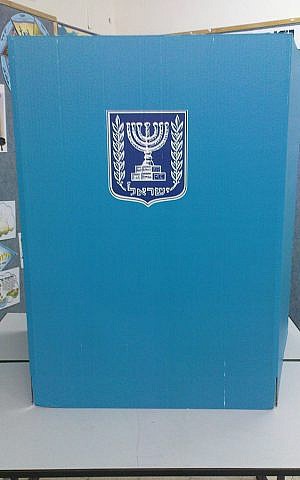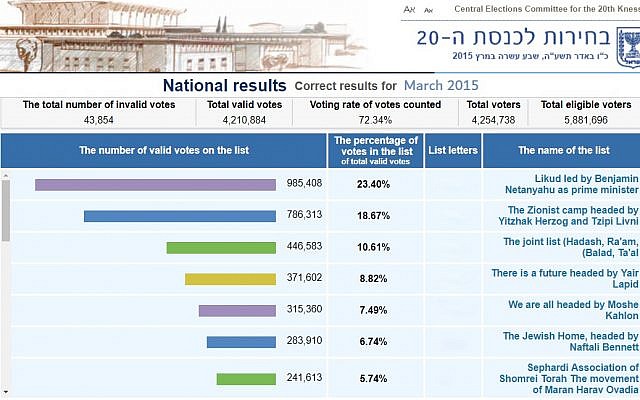Israel’s Knesset Elections 101
AJT breaks down Israel's Knesset elections, which will take place on April 9.
Dave Schechter is a veteran journalist whose career includes writing and producing reports from Israel and elsewhere in the Middle East.
On April 9, Israelis will elect the members of their national parliament, called the Knesset.
In Israel, citizens vote for their preferred political party, not for individual candidates. The number of votes a party receives determines the number of Knesset seats it holds.
The make-up of the Knesset determines who becomes prime minister. There are 120 seats in the Knesset, a word drawn from the Hebrew for “assembly.” The Knesset meets in Jerusalem.
To be represented in the Knesset, a party must receive at least 3.25 percent of the vote, which usually translates to three or four seats.
The number of seats a party receives is related, roughly, to the percentage of the vote it receives. Votes for parties that do not meet the threshold are redistributed by a somewhat complicated formula involving parties that do qualify for seats.
The Knesset is a legislative body that passes laws (by a majority vote), elects the nation’s president (a largely ceremonial post), and approves the cabinet created by the prime minister.
Knesset members are elected at-large, meaning that they represent the entire country rather than a specified geographic area, unlike the United States, where members of the House represent districts and members of the Senate represent states.
Members are elected to four-year terms, but elections can be held earlier if the Knesset dissolves itself or is dissolved by the prime minister.
Israelis are eligible to vote at age 18. Election day is a national holiday in Israel, unlike in the United States. There is no obligation to vote, but in 2015, some 72 percent of eligible Israelis voted, the highest turnout since Israel’s 1996 election.
Unlike the United States, which allows its citizens to vote from abroad, Israelis must be in their country to vote. The only exceptions are for diplomatic and military personnel posted outside of the country.
In this election, Israelis will choose from among 13 political parties certified by the board of elections. Each party has released a priority list of its candidates. For example, if a party wins votes that translate to seven seats in the Knesset, the first seven people on its list will take those seats.
Some parties create their lists through primaries in which registered party members vote. In other cases, party leaders make the selections.

The need to meet the 3.25 percent vote threshold often forces smaller parties to merge. Individually, they might not win enough votes for a Knesset seat, but together their chances improve. No single party has ever won enough seats (a minimum 61 out of 120) to form a government on its own. The bigger parties must draw smaller parties into a coalition to form a majority bloc.
The task of forming a government usually, but not always, goes to the party winning the most votes. The president of Israel makes this decision and has the option of turning to another party if it is thought to have a better chance at accomplishing this task.
The president nominates the leader of the party that forms the government to become prime minister, pending a vote of confidence from the Knesset.
The 21 percent of Israeli citizens who are Arab have voting rights and there are Arab political parties that field candidates for the Knesset.
Israel has become known as the “start-up nation,” but its voting method is decidedly low-tech.
At polling stations, Israelis present a national identification card and are given a blue envelope. They take the envelope into a screened booth, where a ballot for each party is laid out on a table. Voters pick a ballot, seal it in the envelope, walk out and place the envelope in a blue ballot box.
Ballots are counted by hand. Results are expected overnight and made official eight days later. The next Knesset – Israel’s 21st – will be sworn in April 23.
Prime Minister Benjamin Netanyahu, leader of the Likud party, has held the top office since 2009 (and also from 1996 to 1999.) If he remains in office in July, he will surpass David Ben-Gurion as Israel’s longest-serving prime minister. There are no term limits for prime minister.
Elections were scheduled for November 2019, but Netanyahu moved up the date to April. The speculation was that Netanyahu wanted the election to take place before Israel’s attorney general decided whether to follow a police recommendation and indict Netanyahu in connection with corruption investigations.
Attorney General Avichai Mendelblit announced Feb. 28 his intention, pending a hearing, to indict Netanyahu in three cases, involving bribery, fraud and breach of trust. The attorney general has said since then that charges will not be filed until after the election.
The polls suggest that Netanyahu’s Likud party faces a tough challenge in its bid to retain control of the government. His primary opposition is a new party called Blue and White, whose leaders include three former chiefs of staff of the Israel Defense Forces.
Overshadowing such issues as domestic security, foreign affairs and the economy, the Knesset election may turn on whether Israelis feel that Netanyahu needs to remain as prime minister or whether it is time for Israel to have new leadership.




comments